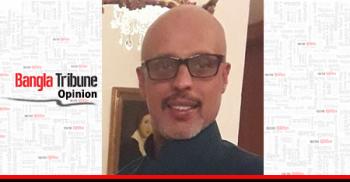 Last Saturday, when I went to the business faculty of Dhaka University after taking my class, the office assistant appeared to be in a state of nervous excitement.
Last Saturday, when I went to the business faculty of Dhaka University after taking my class, the office assistant appeared to be in a state of nervous excitement.
“Sir, guptodhoner news paisen?” (Did you get the news about the buried treasure?).
I had not heard anything of the kind, I said, but was fascinated.
Guptodhon (hidden treasures) in modern day Bangladesh appeared a little far-fetched though when we were young and spent our leisure time devouring books like Treasure Island by RL Stevenson or DwipDipantor by Muntassir Mamoon, our teenage minds wanted to believe in the possibility of finding buried treasure.
So much was the craze of treasure-based storybooks in the decade after independence that quite a few local writers also churned bestsellers.
One was called simply ‘Guptodhon’ and the cover of the book was surely appealing: in a rural setting, a man and his wife holding a hurricane and staring at a large pot of gold coins.
In that placid late 70s and early 80s Dhaka city, when afternoons were tranquil and evenings intoxicatingly mild, one could easily let the imagination run wild.
Ahhh, if we could find something precious buried somewhere!
Our appetites for lost treasure were whetted by tales of lost treasure found by some ordinary village guy, recounted with gusto to us by our domestic helps.
The common tale was that of a poor rural man who found a pot of coins buried inside a derelict aristocratic home.
Long before social media, we had the audacity to be innovative
Since entertainment meant BTV, almost every teenager, growing up in the decades after independence developed the habit of reading. This meant, engrossed in classic adventure tales and then chatting animatedly about the possibility of finding treasure.
But who wants to wait for a map hidden in some old book or a small chest? One day, sometime in 1980, we decided to create the excitement by being a little more daring.
Everyone will get something from their home and then we will bury them in chosen spots behind the school, the plan was made.
When the items are buried we will make maps and after a year, use them to dig up the treasure.
The next day, some brought matchbox cars, others got figures from the army set and I took what seemed like a very attractive thing with flags of different countries.
It was, in fact, an international time difference gadget given to my father by Korean Airlines.
Anyway, during tiffin time we got to it; with the shovel taken from our school gardener the digging began; all the items were neatly placed under two feet of earth. Voila, treasure site made!
Maps were drawn with pencils, spots marked with crosses and smiling in delight we left our treasure spots.
However, the problem began when the search began at home for the timetable. Where is the timetable? The question reverberated. I maintained a solemn face.
Of course, I could not say: I made a treasure of it and buried it behind my school!
The next day, we went for the hunt using the maps – the timetable has to be found!
Believe me, it was thrilling since the guy who marked the spots with crosses did not keep a record of which item was buried in which hole.
Finally, we found it and after going home, I furtively threw it under the bed for someone else to discover.
We found it, the exulted cry was heard soon enough, followed by the puzzled line: “How come there is dirt on the timetable?”
I was deeply lost on Hemendrakumar Ray’s "Jokher Dhon" and pretended to be surprised.
Someone has brought me a chart from the East India Company era
Ok, let’s come to recent times; well, October 2017 to be precise. Yes, long after the treasure books were stashed away, a colleague of mine came to me with an intriguing story.
Someone had come to her from an area near the border in Cumilla with what appeared to be a map of sorts and, it had East India Company written on it.
My weekend lethargy vanished. “Bring it to the office tomorrow,” I said and the next day, my colleague and I were seated with a large rolled parchment. Yep, it had the East India symbol and the name of Lord Cornwallis.
However, looking closely we found that the name of the Englishman had an ‘h’ in the end, making it Cornwallish.
Hmmmmm… this didn’t look right.
The man who had brought the chart told my colleague that he found the parchment and a box of silver coins from 18th century India from the ruins of an old temple near his home.
The setting sounded mouth-watering, but we decided to take the help of an expert, Mr Walker Khan, a collector of artefacts and an expert on British Indian documents and maps.
“It’s a hoax,” he said as soon as we told him the discrepancy in the name. Don’t’ trust these people claiming to bring maps, coins or other items, he warned us and added: “There’s a thriving business of counterfeit archaeological products in India aiming to hoodwink treasure lovers with romantic tales of ancient temples and derelict houses where coins and other precious objects were buried.
Well, that’s that!
In Mirpur, the excavation has not yielded anything as yet and we are told that scanners will be used to trace the mythical treasure.
Whether they find the hidden gold or not, I have suddenly rediscovered my childhood passion for treasure stories.
A forgotten line comes back to mind — Fifteen men on a dead man’s chest, yo ho ho and a bottle of rum.
Towheed Feroze is a News Editor at Bangla Tribune and teaches at the University of Dhaka


